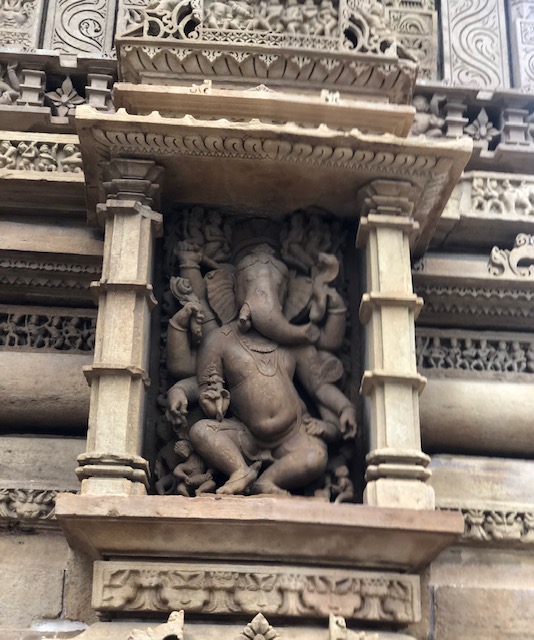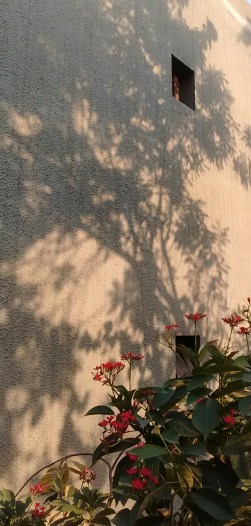Khajuraho. Memories of history textbooks. Also of sniggers and side glances among us as school girls.
When our friends and we decided to visit, it was on a whim. We wanted to see the monuments which are counted among the best in terms of the flowering of Indian art, architecture and creative expression. But we half-feared we would see badly maintained ruins.
What an amazing surprise! We were awe-struck with the boldness of imagination and design of the 25 out of 85 temple structures still standing. We marvelled at how, more than a 1000 years ago, buildings of such complexity and technical perfection could have been built. Even in terms of just moving material and creating such huge structures—how did they manage it? Truly a civilization at the height of its cultural powers.
We were equally impressed with how well the structures have been restored and how well they are being maintained. No ugly and inappropriate renovation. No vandalism. No graffiti. No unpleasant solicitation by guides or vendors. No garbage. No muck.
The cluster of temples (85 at the peak), were built between about 950 and 1050 AD, by kings of the Chandela dynasty. And the eclectic collection of Gods to whom they were dedicated is interesting—Shiva, Vishnu and even Jain temples (Devi temples being conspicuous by their absence). The erotic nature of the carvings in Khajuraho is much talked about, but it constitutes only 10 per cent of the total. And done in a completely matter of fact way, juxtaposed with everyday scenes of life and times.
 What I found most fascinating was the Varaha temple. A temple dedicated to the 3rd avatar of Vishnu–Varaha or Boar. I don’t recall any other temple devoted to this avatar. The sculpture is a humungous sandstone monolith—2.6 metres long and 1.7 metres tall. It boggles the mind how they got the stone up there and carved it. Because carve they did—every inch of the boar’s body is covered with numerous figures. Between the nose and mouth is a carving of Goddess Saraswathi, with the Veena in her hands—a tribute to knowledge. In the Varaha avatar, the demon Hiranyaksha kidnapped Goddess Earth and hid her under the cosmic ocean. Varaha battled the demon for a 1000 years and brought back the Goddess. Well, the Varaha statue has battled the elements for over a 1000 years, and stands testimony even today, to the skill of its creators. It looks fresh, exudes power, and is almost shiny metallic looking.
What I found most fascinating was the Varaha temple. A temple dedicated to the 3rd avatar of Vishnu–Varaha or Boar. I don’t recall any other temple devoted to this avatar. The sculpture is a humungous sandstone monolith—2.6 metres long and 1.7 metres tall. It boggles the mind how they got the stone up there and carved it. Because carve they did—every inch of the boar’s body is covered with numerous figures. Between the nose and mouth is a carving of Goddess Saraswathi, with the Veena in her hands—a tribute to knowledge. In the Varaha avatar, the demon Hiranyaksha kidnapped Goddess Earth and hid her under the cosmic ocean. Varaha battled the demon for a 1000 years and brought back the Goddess. Well, the Varaha statue has battled the elements for over a 1000 years, and stands testimony even today, to the skill of its creators. It looks fresh, exudes power, and is almost shiny metallic looking.


Other sculptures that stand out are a dancing Ganesha. You can see his paunch swaying as he dances! An elephant with a sense of humour, who looks with a twinkle in his eyes, at an amorous couple.
And most interesting of all, a man who is ‘upskirting’ a voluptuous beauty with the help of a device that looks like a telescope. But the telescope was invented only in about 1608!! So what could this device be?
While Khajuraho was an amazing experience, getting there was not! There is an airport, but flights seem seasonal, and only connect to Delhi, Agra and Varanasi. There is a station there, but only serviced by a few trains. We got there by road from Jabalpur. A distance of about 250 kms which took about 6 hours, thanks to 30 kms of potholed roads, and 20 kms of no road at all!
So while I bow to those who conceived and created Khajuraho, and bow to those who have restored and are maintaining it, I definitely do have a bone to pick with those who are doing their best to make getting there such a pain. A real disservice to anyone who wants to see India’s heritage in its glory, a disservice to the world in making access to a World Heritage site so difficult.
–Meena


 Year of the Periodic Table of Chemical Elements, did bring back some memories.
Year of the Periodic Table of Chemical Elements, did bring back some memories.
 Last week, at a Rotary event, I heard Kavita Misra speak. She is a woman-farmer-entrepreneur from the backward district of Raichur, Karnataka. A diploma and PG in Computer Applications, she was married into a traditional family. Though offered a lucrative job in an IT major 20 years ago, she did not take up the offer as her family was not happy to have her take a job. Her husband threw her the challenge to stay in the village and do something. He gave her an acre of land—which was rocky, barren and water-less. Because that was all that was available there. From there to becoming the millionaire famer-entrepreneur she is today was a long and hard journey.
Last week, at a Rotary event, I heard Kavita Misra speak. She is a woman-farmer-entrepreneur from the backward district of Raichur, Karnataka. A diploma and PG in Computer Applications, she was married into a traditional family. Though offered a lucrative job in an IT major 20 years ago, she did not take up the offer as her family was not happy to have her take a job. Her husband threw her the challenge to stay in the village and do something. He gave her an acre of land—which was rocky, barren and water-less. Because that was all that was available there. From there to becoming the millionaire famer-entrepreneur she is today was a long and hard journey. ate on which the Universal Postal Union was established in 1874, in Bern, Switzerland. It was declared as World Post Day at the UPU Congress held in Tokyo in 1969. In just 50 years technology has hugely changed our modes of written communication. Soon there will be an entire generation that has never handled pen, paper, envelopes and stamps, and will never know what the age of physical post was all about. I do feel sorry for them!
ate on which the Universal Postal Union was established in 1874, in Bern, Switzerland. It was declared as World Post Day at the UPU Congress held in Tokyo in 1969. In just 50 years technology has hugely changed our modes of written communication. Soon there will be an entire generation that has never handled pen, paper, envelopes and stamps, and will never know what the age of physical post was all about. I do feel sorry for them!
 bout Gandhi, his thoughts and deeds. This year it is with renewed vigour as it marks the 150th anniversary of Gandhi’s birth. Being the prolific writer that he was, and the wide spectrum of subjects and areas on which he expressed his thoughts, every writer today can find some words of wisdom from Gandhi with respect to whatever they may choose to contribute for the ‘Gandhi special’ editions.
bout Gandhi, his thoughts and deeds. This year it is with renewed vigour as it marks the 150th anniversary of Gandhi’s birth. Being the prolific writer that he was, and the wide spectrum of subjects and areas on which he expressed his thoughts, every writer today can find some words of wisdom from Gandhi with respect to whatever they may choose to contribute for the ‘Gandhi special’ editions.